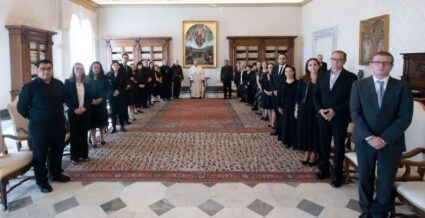Hello and welcome!
As I mentioned in my previous post, last week we had our Plenary Assembly of the Pontifical Commission for the Protection of Minors, which went from Wednesday until Friday.
Following our meeting, we issued the following statement, which details the many issues we dealt with:
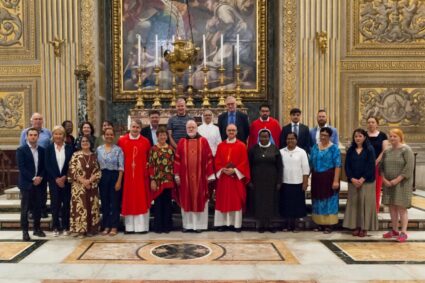
The Pontifical Commission for the Protection of Minors gathered in Plenary Assembly this week to evaluate progress in the implementation of the three main areas of its new mandate one year after the renewal of its membership.
Those areas are: Assisting in updating and implementing safeguarding guidelines throughout the Church (Praedicate Evangelium 78.2); Assisting in the implementation of article 2 of Vos Estis Lux Mundi to ensure welcome and assistance for those who have been abused and preparing for the Holy Father an Annual Report on Safeguarding Policies and Procedures in the Church (Pope Francis, April 29, 2023).
“Earlier this year, our Holy Father instructed the Commission to keep moving forward with the work of safeguarding entrusted to us, which is what the Commission has been doing. He stressed the importance of walking with victims in their pain and finding ways to repair the harm done. In our first year, we launched a global campaign of consultation on a set of comprehensive guidelines that the Commission intends to use in strengthening safeguarding capabilities throughout whole Church,” said Commission President, Cardinal Sean O’ Malley, OFM, Cap.
Cardinal O’Malley continued: “I am very grateful for the commitment of such a dedicated group of safeguarding professionals from all over the world. Our Church is a large entity that includes all peoples and nations, so our task might seem daunting. But we have begun implementing a plan that encompasses the whole Church in its different stages of development. We heard testimony from the UK advocacy group LOUDfence about the calls of those who are seeking a welcoming space in our Churches. We were pleased to welcome Bishop Edouard Sinayobye from the Diocese of Cyangugu in Rwanda who spoke of the ongoing challenges faced by the Church in that country so many years after the genocide and how the Memorare Initiative will help respond.
“By adopting a systematic approach to our work, the Commission will be able to offer support to all areas of the Church’s life where sound safeguarding practices should become the norm. There is still much work to do, but we are confident we are delivering on the tasks asked of us by the Holy Father.”
Safeguarding guidelines:
The Commission reviewed the outcome of the global survey on the Universal Guidelines Framework (UGF) issued in May 2023. More than 300 responses and 700 suggestions were reviewed by the Commission that largely confirmed the approach adopted. The Commission will continue to incorporate feedback until March 2024. Members began working on the second phase of the UFG, which will provide clear criteria for local churches on how safeguarding policies and procedures can become effective. This will involve the issuing of 5-7 criteria related to each of the 10 UGF principles and that point to certain skills required in each diocese to ensure the UGF is being implemented.
Ad Liminas:
Since the beginning of the year, the Commission has hosted 13 bishops’ conferences on their Ad Limina visits. These dialogues are an opportunity for the Commission to review safeguarding policies and procedures, identify gaps and offer feedback and assistance at a local level with follow up through the Commission’s four Regional Groups: Africa and Madagascar, Americas, Asia/Oceania and Europe. The Commission reviewed reports on the Ad Limina visits and drafted recommendations to be shared with the respective local church and that will be published in the Annual Report.
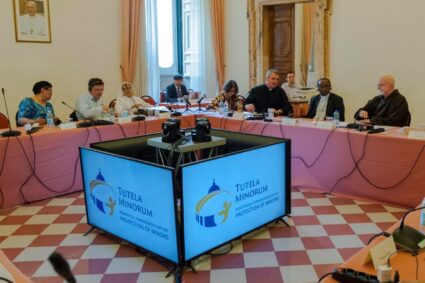
Building safeguarding capacity in local churches:
The Commission oversees a funding mechanism sponsored by Church donors who have committed to providing $2.5 million in funding for those parts of the churches with scarce resources. A financial accountability mechanism for use of these funds was published and implemented as part of a program called Memorare and is available on the Commission’s website. The Plenary heard reports from the Regional Groups on progress in their area, with a focus on the needs in Africa. Twenty local churches – comprising bishops’ conferences and conferences of religious – expressed their desire to avail themselves of the program. During the meeting, the Commission President signed a Memorandum of Understanding with the Church in the Central African Republic. This is the second Memorandum of Understanding with the Commission following an earlier one signed with Rwanda in May this year.
Transparency and Accountability via Reporting:
The Commission spent an entire day discussing and editing work related to the Annual Report on Safeguarding Policies and Procedures in the Church requested by the Holy Father. The Commission approved a blueprint of the Annual Report, which will be made available on the Commission’s website by the end of September 2023 with a view to publishing the first Annual Report in the Spring of 2024. As part of this process, the Commission reviewed the status of collaboration agreements with the Roman Curia. It also met with the Superiors of the Dicastery for Eastern Churches.
The Plenary also heard a presentation by David Smolin, Professor of Law at Samford University’s Cumberland School of Law, on the applicability of the concept of transitional justice to the Church’s work in combatting sexual abuse. The Commission noted the overlap between the categories of transitional justice and church social teaching on justice, reparation, and prevention. The Commission will explore ways to incorporate this way of dealing with significant human rights abuses into its Annual Report. Professor Smolin’s address will be posted to the Commission website before the end of September.
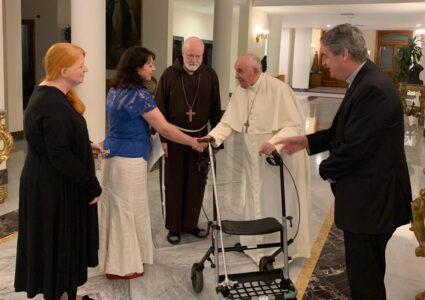
Empowering the victim/survivor community:
The Commission would like to express its profound gratitude to the victims’ advocacy group LOUDfence. Antonia Sobocki and Maggie Mathews opened the Plenary Session with a presentation and testimony. LOUDfence advocates for greater welcome of survivors in the Church. In an opening liturgy, the Commission engaged in a LOUDfence action, where victims and survivors of sexual abuse are remembered through the ritual use of the written testimony of survivors. Antonia and Maggie were later received by the Holy Father in the Domus Sanctae Marthae. During their brief greeting, the Holy Father called LOUDfence “A sign of hope.”
On the final day of our Plenary, I had a Mass with members of the commission in the Chapel of the Choir in St. Peter’s Basilica.
I had never been in that chapel before, and I thought it was stunning.
Also this week, our Commission issued the following statement:
A Call to Action on the Occasion of the Consistory for the Creation of New Cardinals and the 16th Ordinary General Assembly of the Synod of Bishops
Solidarity with those who hunger and thirst for justice
As the Pontifical Commission for the Protection of Minors, we express our deep sorrow and unwavering solidarity first and foremost to the victims and survivors of so many despicable crimes committed in the Church. Every day seems to bring forth new evidence of abuse, as well as cover up and mishandling by Church leadership around the world. While some cases are subject to intense reporting in the media, others are hardly known–if at all–leaving many countless people to suffer in silence. All abuse involves the anguish and pain of a terrible betrayal, not only by the abuser, but by a Church unable or even unwilling to reckon with the reality of its actions.
We hear and are disturbed by reports of the actions of individuals holding responsible offices within the Church, the cries of those impacted, as well as the legacy of atrocious behavior associated with lay and other movements and so many areas of the Church’s institutional life. We are profoundly shaken by the immense pain, enduring suffering and revictimization experienced by so many, and we unequivocally condemn crimes and their impunity perpetrated against so many of our brothers and sisters. We reaffirm our steadfast commitment to work to ensure, as much as possible, such heinous and reprehensible acts are eradicated from the Church.
Recent publicly reported cases point to tragically harmful deficiencies in the norms intended to punish abusers and hold accountable those whose duty is to address wrongdoing. We are long overdue in fixing the flaws in procedures that leave victims wounded and in the dark both during and after cases have been decided. We will continue to study what is not working and to press for necessary changes so that all those affected by these atrocious crimes get access to truth, justice, and reparation. We also pledge to use our role to press other Church officials with responsibility to address these crimes to fulfill their mission effectively, to minimize the risk of further transgressions, and secure a respectful environment for all.
A Call for Conversion Among Church Leaders
Our Commission was established shortly after the election of Pope Francis in 2013. In harmony with the Council of Cardinals, the Commission has overseen a series of initiatives that have highlighted the reality of sexual abuse and the need for robust reforms in confronting both abuse and its mishandling by Church leaders. We are now in the process of aligning our efforts more closely with those of the Dicastery for the Doctrine of the Faith and all those parts of the Roman Curia whose work impacts safeguarding around the world.
However, five years after the 2019 Summit on the Protection of Minors that gathered Church leaders from all over the world, deep frustrations remain, especially among those seeking justice for the wrongs done to them. No-one should have to beg for justice in the Church. The unacceptable resistance that remains points to a scandalous lack of resolve by many in the Church that is often compounded by a serious lack of resources. Pope Francis has warned that the inequalities in the world should not infect the Church.
There can be little effective change in this area without the pastoral conversion of Church leaders. As the College of Cardinals gathers in Consistory we are encouraged by the Holy Father’s frequent reminder to those called to this special role that the blood they are called to pour out is their own and not that of those under their care. As a model of courageous self-sacrifice, the creation of new Cardinals is an opportune moment for reflection, repentance, and renewal of our unwavering commitment to safeguard and advocate for the most vulnerable, using all means possible.
We call upon all those in the Sacred College to remember victims and their families and to include as part of their oath of fidelity a commitment to remain steadfast in honoring those impacted by sexual abuse by uniting with them in the common pursuit of truth and justice. All bishops and religious superiors should echo this commitment.
Together with all those who are worn down by abuse and its consequences, we say: “Enough!”
A Catholic Call for Change
An important moment in furthering these efforts is found in the upcoming 16th Ordinary General Assembly of the Synod of Bishops. The reality of sexual abuse in our Church goes to the heart of the Synod’s agenda. It deals with who we are as a community of faith, founded on Jesus. It permeates discussions on leadership models, ministry roles, professional standards of behavior, and of being in right relationship with one another and all of creation.
We ask that sexual abuse in the Church permeate your discussions as they address teaching, ministry, formation, and governance. As a community of the reconciled, the Church’s sacred worship should also find adequate inclusion and expression of this most intimate of Church failures. While at times it may seem like a daunting set of questions to face, please rise to the challenge so that you may address, in a comprehensive way, the threat posed by sexual abuse to the Church’s credibility in announcing the Gospel.
We urge you to dedicate meaningful time and space to integrate the testimony of victim/survivors into your work. Indeed, many if not all of the Synod’s participants have their own experiences of confronting or dealing with sexual abuse in the Church which could become an explicit part of your deliberations.
We urge you to work towards the day when all ministries in the Church become places of welcome, empathy and reconciliation for those impacted by abuse. Join with those who rail against the endemic complacency of those in the Church and society that silence these testimonies, minimize their significance, and stifle hope for renewal.
We urge you to work towards the day when our Church takes full account and full responsibility for the wrongs done to so many in its care.
We urge you to work towards the day when all children are protected by appropriate safety policies and procedures, ones that are known and verified.
We urge you to work towards the day when transparent and accessible systems of redress for wrongdoing by the Church’s ministers function well according to acceptable standards.
We urge you to work towards the day when all in our Church understand and take responsibility for robust safeguarding in dioceses and parishes and schools and hospitals and retreat centers and houses of formation and all the other places where the Church is present and active.
That day is yet to arrive. And for many it seems a long way away.
We make our own the message given to us by Pope Francis during our most recent audience. He said:
“[W]here harm was done to people’s lives, we are called to keep in mind God’s creative power to make hope emerge from despair and life from death. The terrible sense of loss that many experience as a result of abuse can sometimes seem a burden too heavy to bear. Church leaders, who share a sense of shame for their failure to act, have suffered a loss of credibility, and our very ability to preach the Gospel has been damaged. Yet the Lord, who brings about new birth in every age, can restore life to dry bones (cf. Ezek 37:6). Even when the path forward is difficult and demanding, I urge you not to get bogged down; keep reaching out, keep trying to instill confidence in those you meet and who share with you this common cause. Do not grow discouraged when it seems that little is changing for the better.
Persevere and keep moving forwards! ” (emphasis added)
We urge you to work towards these long-overdue goals not just for one or two days during your gathering, but to consider them throughout the entire Synod process. Their achievement will be a singular sign of the Synod’s success, a sign that we are walking with the wounded and the forgotten as disciples of the one Lord, in search of a better way.
Saturday morning, we had a Mass with representatives of the Latin American Council of CEPROME (The Interdisciplinary Research and Training Center for the Protection of Minors) at the Tomb of St. Peter.
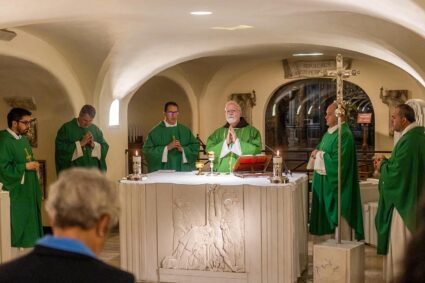
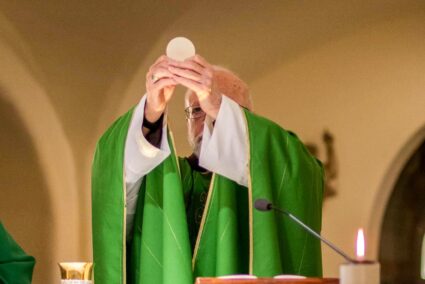
Later that day, there was a book launch for “Transparency and Secrecy in the Catholic Church” by Father Jordi Pujol and Father Rolando Montes de Oca which was published by CEPROME.
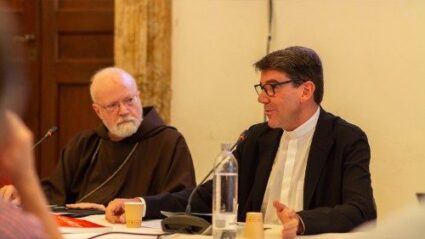
Monday, the CEPROME members and I had an audience with the Holy Father in the Apostolic Palace.




The Holy Father made this address to us:
I am happy to receive you on this coincidence that unites you in Rome from various parts of Latin America. It is also curious that this meeting should take place on 25 September, a date on which, according to ancient tradition, the memorial of a martyred child is celebrated in a small shrine in Spain. Regardless of the fact in question, what makes the story interesting is that the tragedy of that child was associated with that of Jesus Himself, and in his representations, he appears dressed like the Lord, both while he walks to Calvary and while he suffers the Passion itself.
This fact, which may seem anecdotal, brought to my mind the Gospel account of the Final Judgement in which we hear the unsettling words of the great King: “Truly, I say to you, as you did it to one of the least of these my brethren, you did it to me” (Mt 25:40). How the world would change if we were to convince ourselves inwardly that every little one that we meet is a reflection of the face of God! If we were to see in the suffering of each child, each vulnerable person, a line impressed on the veil with which Veronica dried Christ’s face!
I am well aware that you endeavor to work and apply ever more appropriate methods to eradicate the scourge of abuse, both in the Church and in the world. We must not forget: the abuse that has afflicted the Church is but a pale reflection of a sad reality that involves all humanity and to which, above all, the necessary attention is not paid. Some may say: “Ah, there aren’t so many, then”. Even if it were just one, it would be scandalous, just one; and there are more than one.
I think I can say that the Church has made sufficient progress on this path, and will not cease to do so, and this is due to prophetic pastors, a cardinal, who was able to grasp a nettle such as Boston at that time, and go ahead, focusing his care not on the money but on the people and the hurt children. And that is why I want to thank you publicly, Your Eminence, for what you have done. I think I can say that the Church has made a lot of progress in this, and it will not stop doing so. There must also be significant work for society, so that the steps and achievements of the Church in this journey can be an incentive for other institutions to promote this culture of care.
Furthermore, today I would like to propose, starting from this image that identifies each one of the young with Christ Himself, that our effort not be limited to the mere application of protocols, but rather that we entrust them to Jesus in prayer. With humility and truth, we must know how to recognize them among those ‘little ones’. And, before the Redeemer, let us also contemplate in that affronted face the suffering we have received and caused, so that we do not feel distant from the people we welcome, but brothers, even in pain. Let us dialogue with Jesus, let us listen to that Word that forgives us, that heals us, that redeems us all. He did not take on the sin of the world to condemn it, but to save it, and He taught us that there is no greater love than that which gives life, that which leaves it in a trace of His Holy Face.
Let us love each other, Jesus tells us, as we love ourselves; that is, aware of our wounds, of our smallness, of our need for forgiveness and consolation. And let us pray, with the confidence that Saint Therese of the Child Jesus teaches us, in these days that precede your festivity, for the unhappiest and most desperate sinners, for their conversion, so that they may see in others the eyes of Jesus who calls out to them.
I do not want to pass without drawing attention to a problem that is very serious in the area of abuse, the filming of child pornography, which unfortunately, by paying a small fee, can already be downloaded to a phone. Where is this child pornography being made? In which country is it being made? Nobody knows. But it is criminality put at the service of everyone through their cellphones. Please, let’s talk about this too. Because these children who are filmed are victims, sophisticated victims of this consumer society. Don’t forget this point, which worries me a lot.
May God bless you, may Our Lady watch over you, and keep on fighting like this, keep on fighting. Thank you.
Thursday, I was visiting St. Peter’s while they were celebrating the ordination of transitional deacons from the Pontifical North American College.
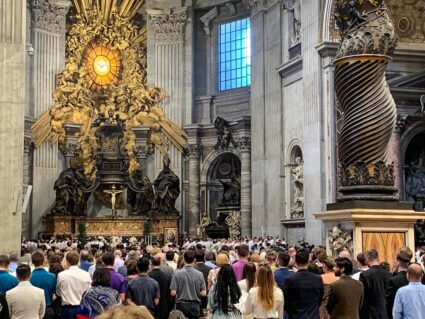
Aside from the ordination, there were great crowds in the basilica.
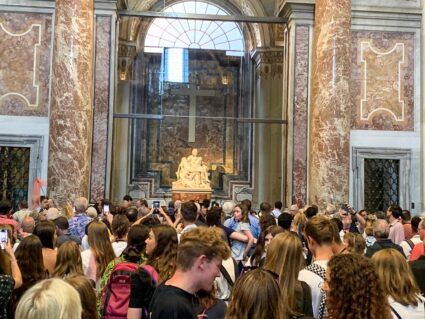
As I was looking around, I noticed a painting that I had never seen before.

It depicts St. Peter with Ananias and Sapphira, the members of the early Christian community who didn’t make the contribution they were supposed to and were struck dead. I thought that was an interesting theme to use in a church!
There are also the very beautiful altars of the Presentation of Mary and the Immaculate Conception.

 I was also very happy to see Father Mario Castañeda, who had been my secretary in Palm Beach.
I was also very happy to see Father Mario Castañeda, who had been my secretary in Palm Beach.
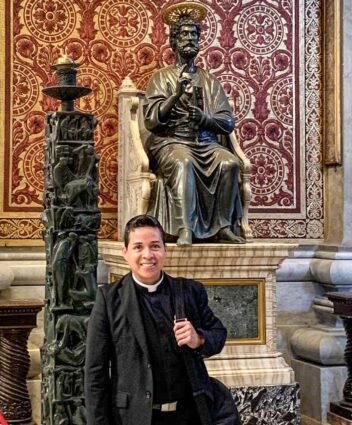
I also attended an event at the University of the Holy Cross for Rome Report’s new documentary on the Holy Father, “¡Sorpresa! El Papa llama a la puerta” (“Surprise! The Pope is knocking at the door”).
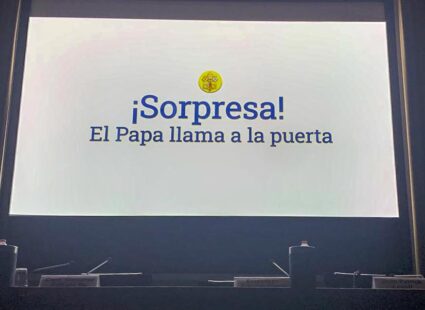
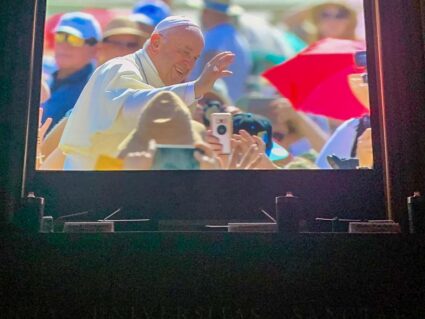
After showing the film, they had a panel discussion moderated by journalist Francesco Grana, where we heard remarks by Cardinal Re, co-director Sean-Patrick Lovett, and Vatican journalist Valentina Alazraki.
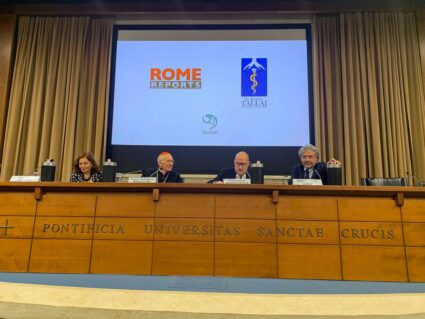
I thought the film was excellent and I’m hoping we can show it on CatholicTV.
Finally, I want to share with you this photo of what I call “The Green Monster.”
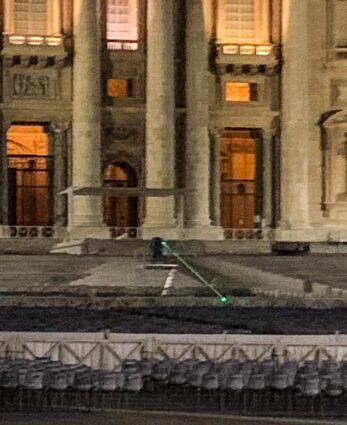
During the pandemic, because there were no people around, seagulls practically took over St. Peter’s Square. So, they have this green laser device to chase them away. It looks like something out of “The War of the Worlds” — but it works!
Until next week,
Cardinal Seán

